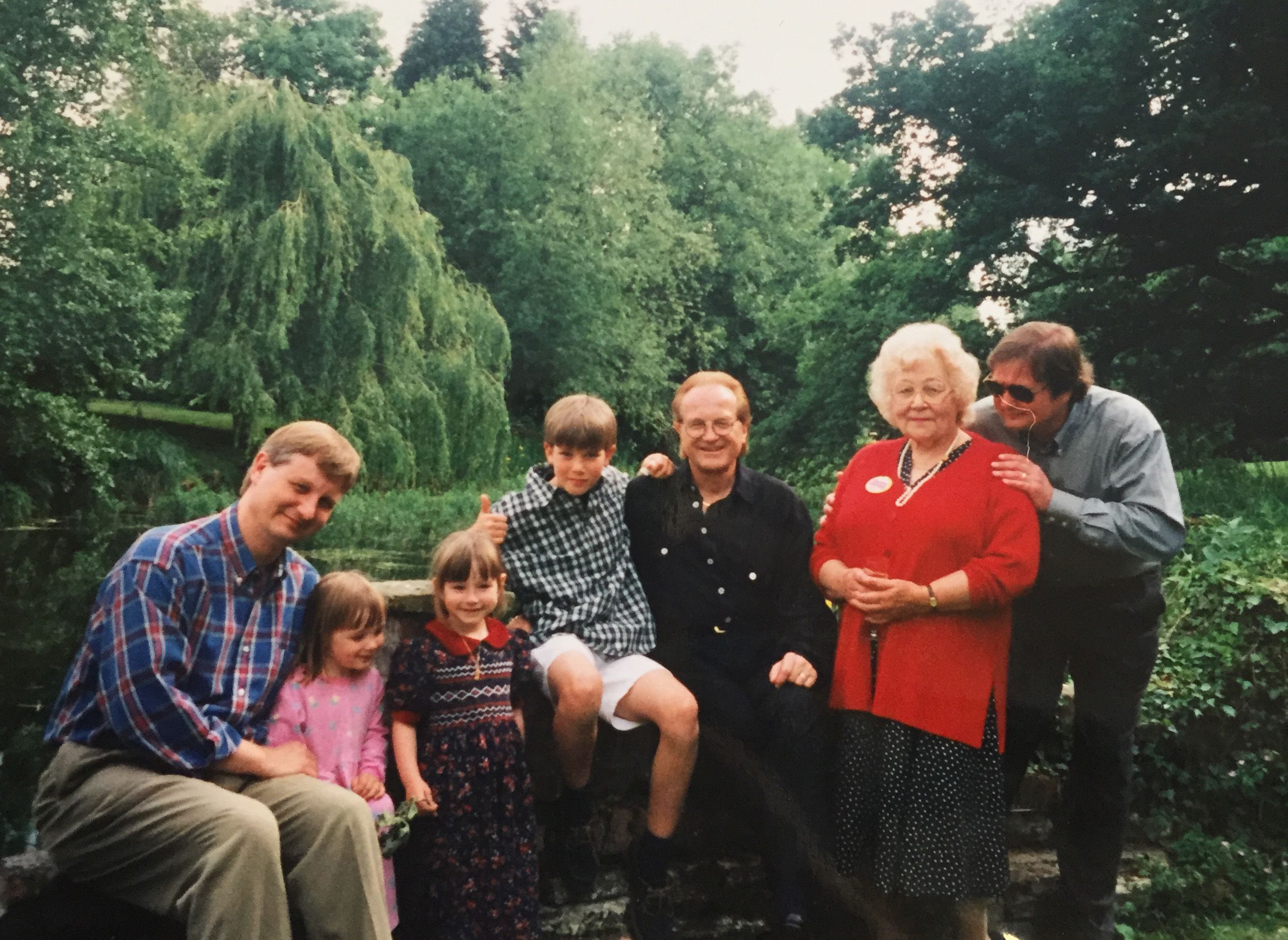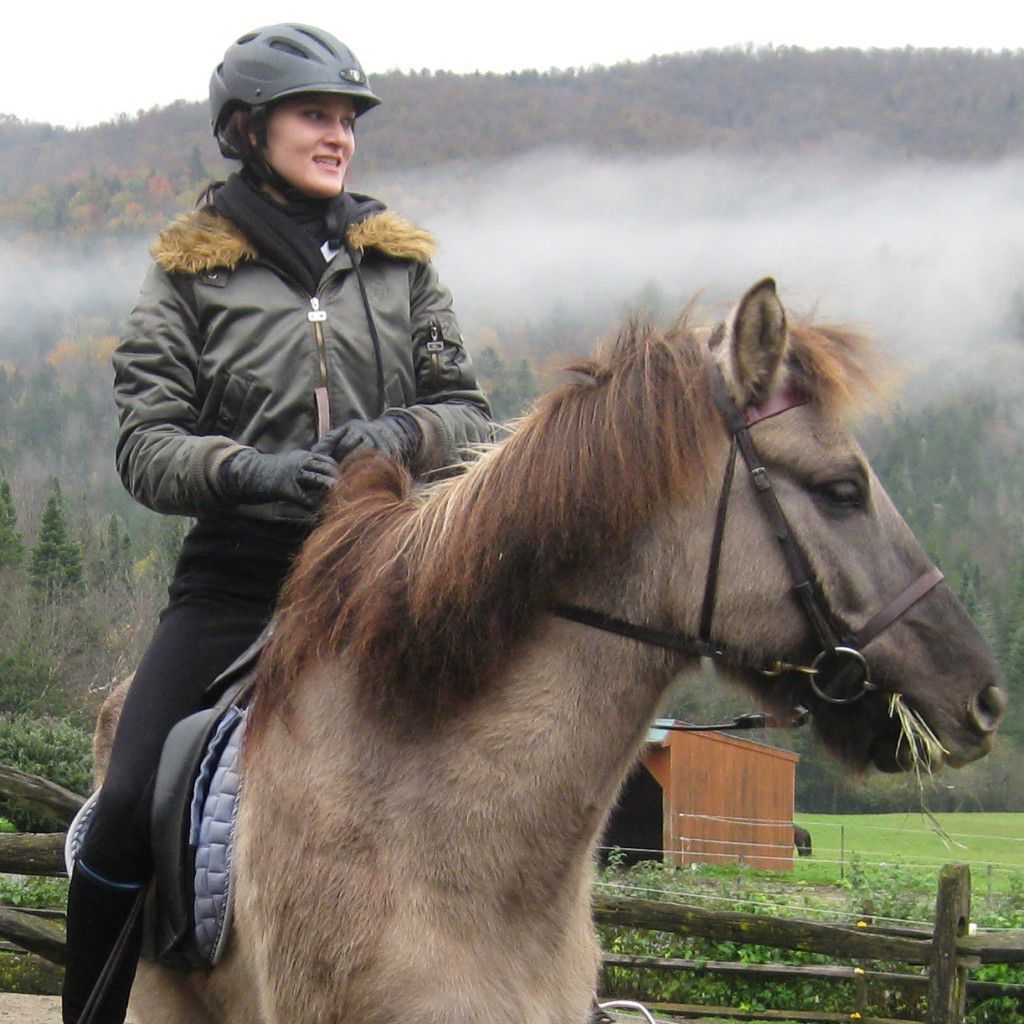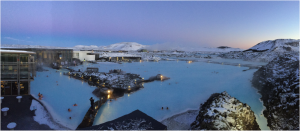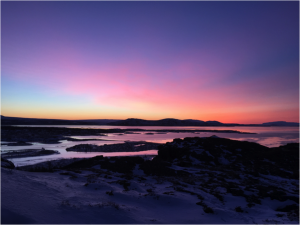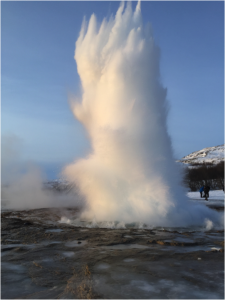How did you get your surname?
Do you know how you got your surname?
It is regarded as a tradition for women to take their husband’s surnames when they get married in Britain. It’s also the tradition for men to always be Mr but women will be Miss until they’re married and become Mrs. So if Miss Young married Mr Smith, she would become Mrs Smith. A survey in 1994 showed that 94% of British women decided to take their husband’s surname when married. This ‘tradition’ is no longer as common today, with many women choosing to keep their own surname, or creating a double-barrelled surname.
In Poland many women choose to take their husband’s surname when they get married. However, they have masculine and feminine endings to their surnames. My surname – Koszykowska – like many Polish names ends in ‘ski’ for males or ‘ska’ for females; my dad follows this rule, as does one of my uncles, but the other uncle keeps its simple by using ‘ski’ for his family. It’s thought that originally Polish surnames ending in ‘ski’ or ‘cki’ came from the places where people lived; so if you lived in Wola you would become Wolski.
In Iceland the family name reflects the immediate father’s name or in some cases the mother’s. This is a more complex way of creating a surname compared to the British tradition. If Jón Einarsson had a son called André, André’s surname wouldn’t be Einarsson; instead it would be Jónsson. This is a combination of his father’s first name ‘Jóns’ (the s indicates that he is literally Jón’s son) and the Icelandic word ‘son’. If Jón had a daughter her surname would be Jónsdóttir, dóttir being the Icelandic word for daughter. In some cases they may use the father’s middle name, or their grandfather’s name.
In Spain it’s the norm for children to take the surname of the father and their mother’s maiden name to form one surname. For example if Alejandro López marries Daniela Rodriguez, their child Paula will take the father’s surname López as their second name and their mother’s Rodriguez as their third; Paula López Rodriguez. Then it gets slightly more confusing: if Paula marries she won’t change her surname; instead she will add it to her name. For example, she marries Álvaro Arroyo; her name will become ‘Paula López Rodrigues de Arroyo’. This continues when Paula has children, her mother’s surname will be dropped from their surnames to become ‘López Arroyo’.
Is there an interesting story behind your surname? Let us know!
Alex
How to keep New Year’s resolutions
We’re well settled into the new year and we’re all full of hopes and dreams for the next 12 months – learning a new language, getting fit, changing our job, travelling more. Most likely in the first week of the year you were super pumped, ready to drop anything to stick to your main goal(s).
By the time the second week came however, you kind of settled in, relaxed the rules a bit and got back to some of your old habits. When January’s over, your goal will be completely forgotten like it was never there and you’re going to be thinking ‘how silly of me to think that I could learn Spanish’.
That can be one of the ways the future looks. Let’s take a different turn. Lets push through the phase when we want to give up and see what happens. The other road is familiar but wouldn’t it be nice to see what else can happen? What if you did learn Spanish this year? You could read books in Spanish, and you could talk to other Spanish speakers, and on your next holiday in Spain you could strike up a conversation with a stranger and end up making new friends.
Studies have shown that the human brain tends to value immediate rewards more than future rewards. When you set a goal or a resolution you are in fact making plans for your future self and it ‘s easy to imagine how your life can look. But, when the time comes that you actively pursue that goal most people choose immediate gratification and opt to do what they feel like in the moment.
Now that we understand how our mind works, it’s time to find ways to stop this from happening.
- Start slowly and build a ritual. Set yourself to practice for half an hour a day – that’s not too much to ask right? Offer yourself a reward after – if you’re learning a language with uTalk, the reward comes in the form of earning points and we all like to build up to a nice score, right?
- Put aside some of your other tasks. Obviously not work or eating but if you usually browse the Internet while commuting why not replace that with your main goal?
- Keep your eyes on the prize – never lose sight of your motivation. Look at pictures of beautiful Spanish landscapes and imagine yourself having a chat with the locals, or listen to Spanish songs and try to understand the lyrics.
I hope this helps you push through the temptation of giving up and will ultimately get you to your goal. And don’t worry about making mistakes; the only person who loses is the one that gives up, so no matter how slow you are going, it’s still better than if you weren’t doing anything.
And if your goal is to learn a language (or twelve…), there’s still time to join the uTalk Challenge!
Ioana
Icelandic is not like chicken
by Patricia Ochman
My initial reason for taking on Icelandic was pretty pragmatic: I had started riding Icelandic horses and purchased a friendly Icelandic gelding, Léttfeti. I felt that picking up some Icelandic would allow me to get access to a treasure chest of information about my favorite breed and help me better understand my Icelandic best friend.
I took on a uTalk challenge and started learning Icelandic. Since I know Danish, I figured, how hard could it be? I would have this down in 30 days, no problem.
Well, fruits and vegetables were fine… but then it got thorny. Very thorny, very fast. Icelandic, it turns out, is not that similar to Danish. My initial enthusiasm turned into frustration because I thought this was supposed to be easy. Why were there three genders, four declensions, unusual pronunciation, weird words in weird places?
I gave up. It was too complicated, too different. Sorry Léttfeti, we’ll have to stick to English.
Until one day, I remembered that when I was younger, I refused to learn declensions in Polish because English and French (languages I already spoke) had no declensions. That’s when my teacher said, “That’s just the way it is; Polish has declensions and you’re going to have to learn them.” That response later resonated in my head when my Latin teacher made us repeat “rosa, rosam, rosae, …”. That’s just the way it is in Latin, I thought. I learned Polish and I learned Latin and I accepted declensions. I even started thinking that declensions add richness to a language, just like the pluperfect subjunctive tense adds richness to French.
Later on, I learned Finnish and because I had been told that Finnish is unlike any other European language, I just started from scratch, not assuming I would know anything at all. Hyvää päivää, olen Patricia. It went well and I progressed at a satisfying pace. It was unfamiliar and beautiful.
So then, why was I so frustrated with Icelandic? Could it be that my frustration had nothing to do with the language and everything to do with the fact that I was trying to fit a square peg in a round hole? It is certainly a very comforting feeling to think that something that is new to us is similar to something we already know. After all, we are regularly told “try it, it tastes just like chicken”… But doesn’t that just defeat the whole purpose of trying something new? How about “try it, it’s nothing like chicken, it’s totally unique and your mind may just be blown”?
I was trying to make Icelandic seem similar to something I already knew when it really wasn’t, and that’s what hindered my progress. I tried to put myself in the same mindset I had for Finnish and just told myself that this would be different. I’d have to let go of the buoy I was apparently desperately hanging on to and I’d simply have to embrace Icelandic for all its… well, Icelandicness.
I started focusing on the things I already knew in and about Icelandic and built on that. I tried to figure out its internal logic, its particularities, its flow. I started repeating out loud the words and sentences I learned and slowly made sense of them. Eyjafjallajökull is really not that scary when you understand that it’s just a juxtaposition of “islands”, “mountains” and “glacier”. Icelandic started to make sense and I started loving it. I’m still a beginner, but I’m now an excited beginner, unafraid of straying from what I already know. Vel gert!
I believe learning languages expands one’s mind, and this may be a reason why. Learning a new language means getting out of that familiar English, French, German, etc. playpen and discovering new ways of organizing and expressing thoughts. Scary at first, sure, but oh how rewarding.
10 reasons to visit… Iceland
Last weekend I had the very fortunate experience of being taken to Iceland for my birthday. I was only there for three full days and I don’t think I have ever fallen in love with a country as quickly as Iceland. Here are my top ten reasons to visit, but first, if you ever get the opportunity to go, take it; I guarantee you wont regret it.
1. Blue Lagoon
This was my first port of call from the airport. You can definitely visit the lagoon before your departure or just after you arrive. The lagoon is such a surreal experience; it feels completely wrong to be getting into a bikini when it is -2°C outside. It is a mad dash to get into the lagoon but once you are in you’re instantly warmed up. Swimming around the lagoon you come across warmer patches and under normal circumstances you would be swimming away very quickly, but on this occasion you welcome them. There are free face masks around the lagoon, so everyone looks particularly funny swimming around with grey faces. When we eventually decided to drag yourself away, I have never felt my skin feel so soft. If you have time, sneak up to the viewing platform to really see how blue the water is.
2. Northern Lights
I was very fortunate that I was able to see the Northern Lights (Aurora Borealis) for a whole hour. To try and describe the Lights is very difficult, because there isn’t anything that compares. They suddenly just appear, a glow, which ‘dances’. They move all over the place and constantly change in size and appearance. They need to be on everyone’s bucket list – they are simply beautiful.
3. Food
I hadn’t really heard much about the food in Iceland before except that it was rather expensive. They are in fact known for their seafood and lamb, and I had the best food I have ever had there. I wish there were restaurants like that in London, because the meat was so tender. We ate at Mar and the Seafood Grill, both of which I would highly recommend. For more atmosphere I would pick the Seafood Grill and sit in front of the kitchen. In regard to price, if you have a budget you can stick to it, you may just have to have one course instead of two or three, but it is worth it.
4. Twilight
In Iceland at this time of year the sun doesn’t rise until about 10:30am. I don’t know how they do it, I’d never to be able to get up and be at work when it is still so dark. Before the sun rises you have a twilight period, where everything becomes a very light blue. I have never seen a sunrise with such a vast range of colours. It is also the best light to take some stunning photos in.
5. Landscape
I was able to see where the Eurasian tectonic plate met the North American plate, which was unreal. The landscape is vast and there are a lot of volcanoes, which have shaped the land. As you travel throughout Iceland the landscape drastically changes, but it is stunning at the same time.
6. Snowmobile
Snowmobiling is an adrenaline experience and one where you don’t want any cameras to be around. To get to the snowmobiles you are transported in an old military truck across the Glacier, which is very exciting. On arrival, you have to put a boiler suit on top of your other clothes, as well as a balaclava, a helmet and shoe protectors. They certainly keep you warm, but moving is a little restricted. The snowmobiles were very easy to drive and the added bonus was that the handlebars were heated so your hands couldn’t get cold. This was an additional feature on our tour – if you have the option to add it on too, go for it.
7. Waterfall
I saw the Gullfoss waterfall just as the sun was setting. As you walk down towards it, you can’t actually see the waterfall, just hear it. It isn’t until you turn the corner that you can see it, and it is such a shock to see the sheer size of the waterfall. In winter it is surrounded by snow and ice which I think added to its beauty. Prepare to be stunned.
8. Geyser
I saw the Strokkur geyser, which has reportedly been around since 1789. It explodes every seven to eight minutes and is truly fascinating to watch. You can see the water begin to bubble and somewhat pulse, right before it explodes. When the geyser does erupt it is predominately steam rather than water. You could stand there for hours watching it erupt.
9. Café
On the final day I unfortunately woke up to a very extreme storm, which even cancelled flights. Additionally this meant that the whale watching tour that I was supposed to go on was equally cancelled. However, this turned out to be a blessing; instead I bounced from café to café and it gave me a real opportunity to look around Reykjavik. The cafés were so cool; for much of the day I stayed in one called Laundromat, which has a definite American feel to it, and in the basement you could also do your laundry. Once I had breakfast they didn’t pester me to order more or to leave; I simply sat there and read my book and people watched for hours.
10. People
Everyone was so friendly in Iceland, always smiling and saying good morning or afternoon. In the café or bar people were always chatting to you and sharing experiences about Iceland. They just couldn’t do enough for you.
I had an incredible few days in this amazing country, and I can’t wait to go back and see even more of it, especially the volcanoes.
Have you ever been to Iceland? Have you seen or experienced any of the attractions above? We want to hear about your trip!
Amy
Learning lots of Icelandic!
Góðan dag!
As you may remember, I’ve been learning Icelandic for the January uTalk Challenge. It’s a totally new language for me, with different rules and pronunciation to other languages I’ve studied, and I’ve absolutely fallen in love with it.
There are a few sounds in Icelandic which I really love. One of them, which I’m going to (unflatteringly) call the ‘spitty’ sound, is the sound made by a double ‘L’, as in the word for car (‘bíll’). It’s incredibly satisfying to replicate, although I can’t really explain why – just find an Icelandic person and ask them to say the word for car, or get uTalk and hear our lovely voice artists say it, and you’ll see what I mean.
There are also a few sounds which have just tied my tongue into knots. Although a surprising amount of Icelandic seems vaguely intuitive for an English native speaker, occasionally I’ll come across a preposterously long word boasting a collection of ‘eð’s and ‘þorn’s (the two ‘th’ letters), and it’s really been a case of memorising the words at this stage. It took me absolutely ages to master ‘hjúkrunarfræðingur’ (rather less manageable than English’s nice and simple ‘nurse’) and ‘afgreiðslumaður’ (‘shop assistant’). However, on most topics there have been several items I can make an intelligent guess at, either because they have some connection to the English (‘hjarta’- heart, ‘kókoshneta’- coconut, ‘baunir’- peas, ‘bjór’- beer) or because Icelandic is wonderfully logical at times: it doesn’t take too much imagination to see that ‘á bak við tréð’ indicates ‘behind the tree’, and ‘Ég er með tannpínu’ means ‘ I have (lit. I am with) toothache’. So I have had it slightly easier than some of my colleagues, who have been battling with languages completely unconnected to English.
My technique has been to cram as much in as quickly as possible, launching into the Hard Game first and then going back to Practice to check on what I got wrong. I’ve left all the Recall sections until I’ve completed the other games in all the sections, and then I’ve gone back and used it as a test of how much I remember. I’ve also been pointing to people and things all weekend and saying the word in Icelandic, and getting anyone I’m with to repeat the words back to me. I’ve found this really useful because it makes you assume a certain amount of teacher-like responsibility, so if I’m not 100% sure on what I’ve told them I’ll go back and double-check it. Also, if they repeat back anything nonsensical I realise I’ve probably pronounced it terribly in the first place, and need to revise it. So thank you to everyone who’s put up with me spouting random Icelandic words at them recently! What I now plan to do is to leave the Icelandic for a week and then to come back to it towards the end of January and do all the Recall sections again, and see how much I remember (hopefully a lot).
I’ll leave you with my favourite word so far, which is ‘surfing’ – again, just another really satisfying sound: ‘brimbrettabrun’:
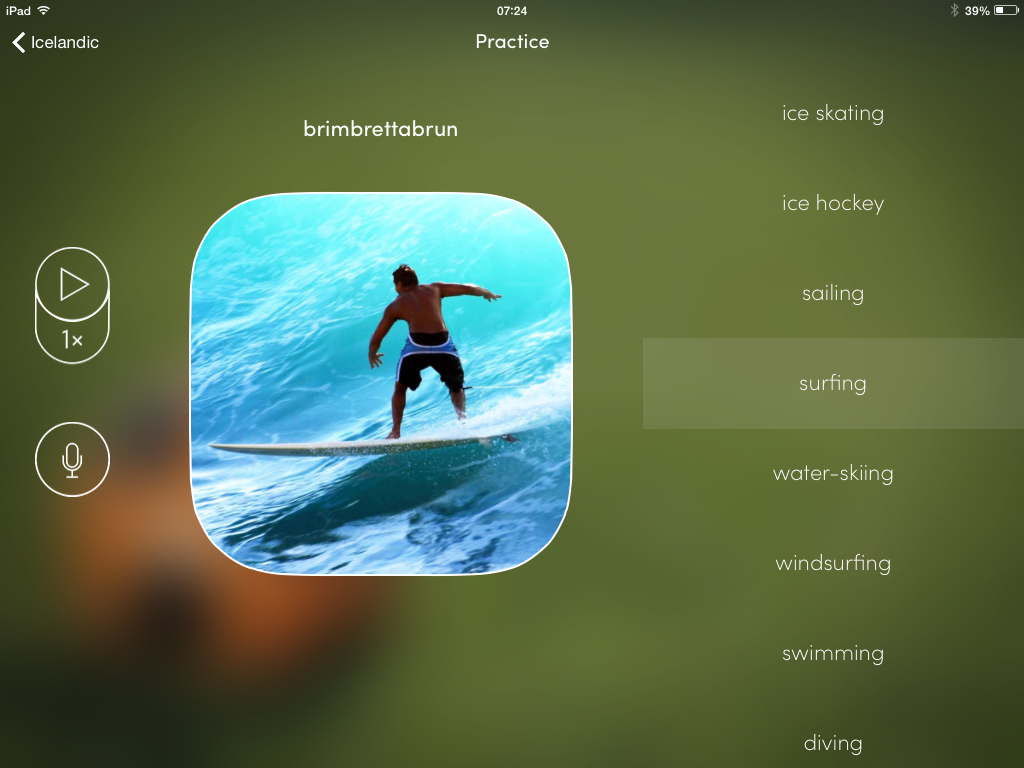 Is anyone else doing the uTalk challenge? How are you getting on?
Is anyone else doing the uTalk challenge? How are you getting on?
Nat
